Reach vs. Impressions is a common dilemma causing confusion amongst marketers and social media users alike.
But that’s understandable:
Social media metrics like ‘reach’ and ‘impressions’ have become marketing buzzwords – everyone is talking about them, but not all understand their essence and, quite frankly, a lot of the time, people use these words interchangeably.
So, understanding the basics, or in this case, the difference between reach and impressions is a good starting point for assessing your campaign success and optimizing your social media strategy.
Let’s jump right in and take a look at what are the differences between these two basic metrics and what this means for your business.
Table of Contents
What’s the difference between Reach vs. Impressions?
The main difference between reach and impressions is that reach refers to the total number of unique users who have seen a piece of content, while impressions refer to the total number of times that content has been displayed, regardless of whether it was viewed by the same user multiple times.
To put it simply, reach shows the number of unique users that were exposed to your content, while impressions show the number of times your content was displayed to these users.
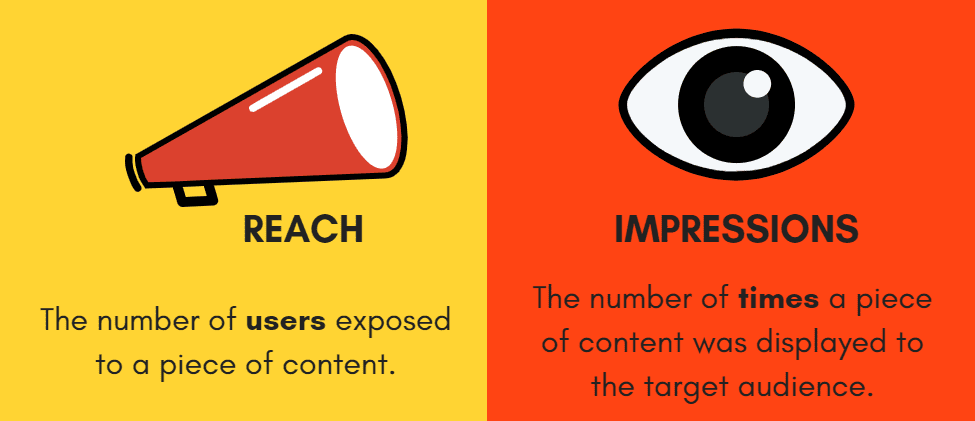
Theoretically, the people that follow you should see each piece of content you publish on social media, right?
That’s why they became your followers, after all – to stay up to date with what you are posting!
Sadly, that’s not the way things work on social media.
Social media platforms use complex algorithms to determine which content to show to which users, and as a result, only a fraction of your following is made aware of your activity every time you publish something.
In fact, this fraction is quite small – especially after the algorithm changes and the much-talked-about decline of organic reach across leading social media platforms in the course of the last couple of years.
Lower overall reach means fewer people seeing your posts, which ultimately leads to a drop in engagement and fewer conversations with potential customers (we’ll talk more about the impact of reach below).
Thankfully, ‘reach’ is not limited to your followers.
In other words, when a follower engages with your content, this activity will also show up on some of their friends’ feeds or explore page.
So, it is not uncommon to see that from the people reached, some percentage are not your followers (say 20% or 30%, or sometimes even 60%).
Now, impressions – they’re always higher than reach, as one person can have multiple impressions for a single piece of content.
Let’s say that five unique users saw your post and that each one of them saw it twice.
That means your reach will be 5, and the impressions 10.
Yes, it’s that simple!
If you are ever confused about these concepts, just remember that reach is related to users, while impressions show the frequency (times the content was shown).
Let’s explore these terms a bit more in detail relative to the most popular social media platforms …
Depending on the importance each platform puts on each of the social media metrics, some apps will show only general insights into reach and impressions, while others will offer a more detailed summary. Social media tools help you build a brand, but to determine how effective your efforts are, you’ll need highly effective analytics tools.
To better understand the reach vs. impressions dynamics, it would be helpful if we discussed how each of the leading platforms defines, calculates and groups these social media metrics…
… which is exactly what we’ll do below.
Facebook Reach Vs. Facebook Impressions
The Facebook Business Ads Help Centre defines reach as “The number of people who saw your adverts at least once.” It further notes that reach is an estimated metric.
Estimated metrics are those metrics that are hard to quantify – the platform gives an estimate using sampled data.
This means that the numbers may change along with the amount of accessible data.
The Facebook Business Ads Help Centre further notes that “reach is different to impressions which may include multiple views of your adverts by the same people.”
In other words, impressions show how often your content was displayed and seen by your target audience.
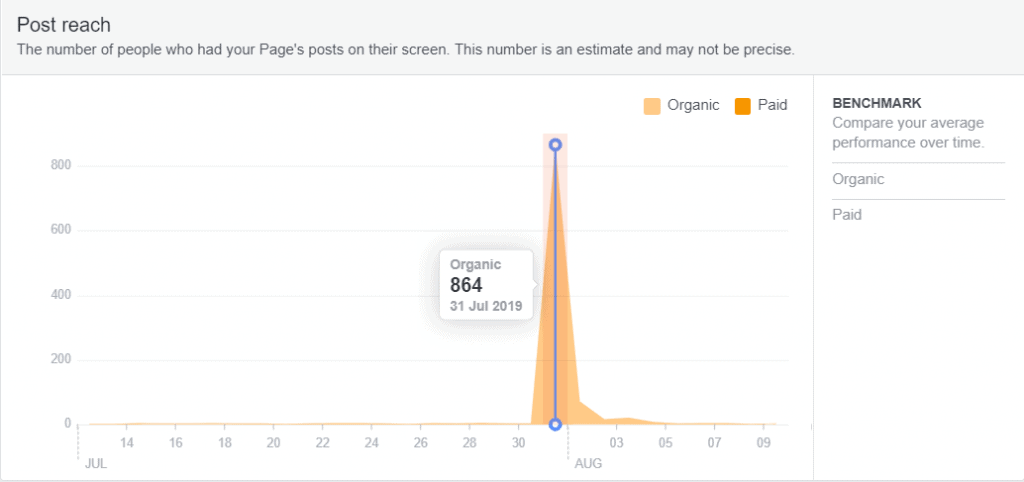
What reach and impressions don’t show is engagement.
Basically, you can’t be a hundred percent sure if a user is actually aware of your content clicked on your ad, or if he/she has just scrolled past it after it was displayed.
To make it easier to measure your success and optimize your strategy, Facebook groups reach and impressions in three categories:
1. Organic
Organic reach and organic impressions show the number of unique users that saw your content or the number of times your content was displayed. You can use Keyhole and add your Facebook page for the real-time updates as well.
2. Paid
Just like the category name implies, paid reach and impressions are the results of your paid efforts, such as Facebook Ads.
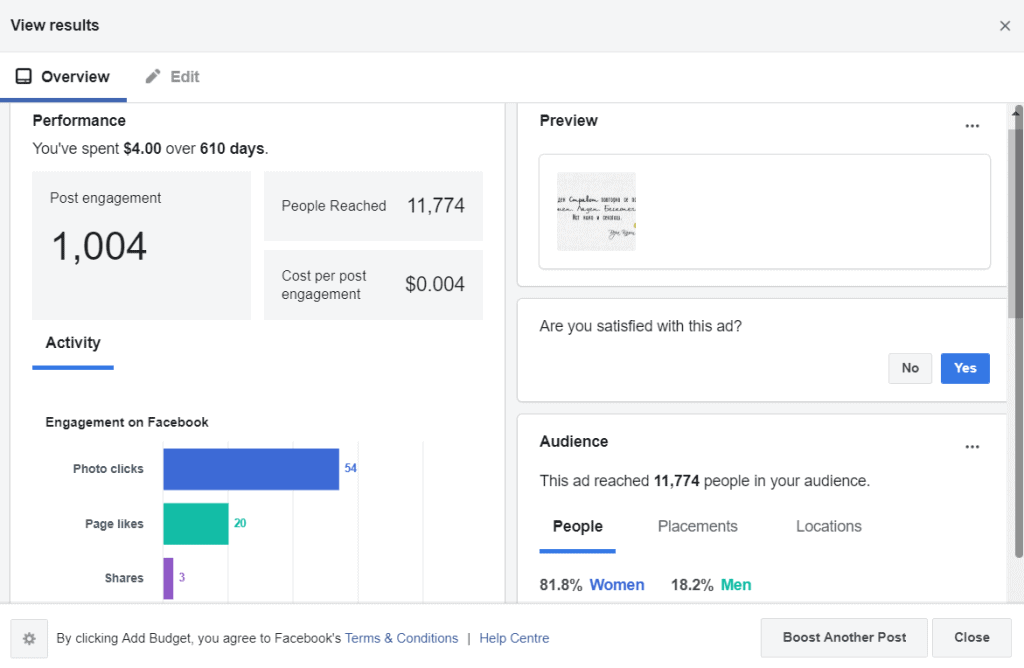
But here’s the catch.
When it comes to video ads, Facebook counts the impressions they get the same way it counts the impressions of an ad that contains an image (except the ads on Audience Network).
As per Facebook’s explanation: “This means that a video is not required to start playing for the impression to be counted.”
So, if a video shows up on a user’s newsfeed and the user scrolls down before the video has started playing – this will still be counted as an impression.
Then, how do you know the real impact of your ads?
Here’s how:
The reach and impressions associated with Facebook Ads can further be classified into served and viewed reach and impressions.
What’s the difference?
Served reach and impressions are related to the system registering the delivery of an ad. ‘Served’ means that the system does not consider whether the user saw the ad – it just cares that the ad has been displayed somewhere.
Now here’s the problem with this.
When an impression has been served, the system does not take into account the placement of the ad.
It can be shown someplace where it will gain exposure like the top of the page, or it can be shown somewhere in the bottom of the page, where it won’t get noticed.
Also, even if a user exited the page before the ad finished loading, the system will still count it as an impression as long as the ad has been delivered.
It’s easy to see why served impressions are not the most accurate measurement of an ad’s impact.
Viewed impressions, on the other hand, count the times a user saw the ad that was delivered to him or her.
In other words, if a user exits the page before the ad has rendered, it won’t count as an impression.
This makes viewed impressions a much better indicator of the ad’s effectiveness.
3. Viral
When explaining the difference between impressions and reach, we mentioned that reach and impressions can expand beyond your list of friends or followers.
In other words, when a person takes action on your page or post, a fraction of their friends and followers will be able to see this action and the related post on their News Feed.
Viral impressions and reach are just that:
The result of your content showing up on the News Feeds of the friends and followers of those Facebook users that engaged with your content.
These engagements can be in the form of a like, a comment, or a share.
Twitter Reach vs. Twitter Impressions
Now take a look at this image.
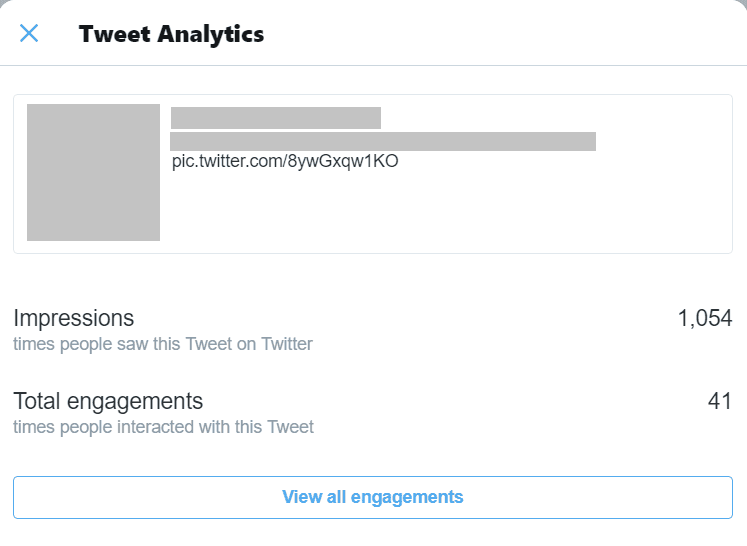
When you access the analytics of a tweet (be it via the web or the Twitter mobile app), you will notice that you can see impressions and total engagements, but there’s no number that shows reach.
Even if you expand the list and choose to “view all engagements,” you will get insight into various metrics like media engagements, retweets, likes, link clicks, and detail expands, but still, ‘reach’ won’t be part of the list.
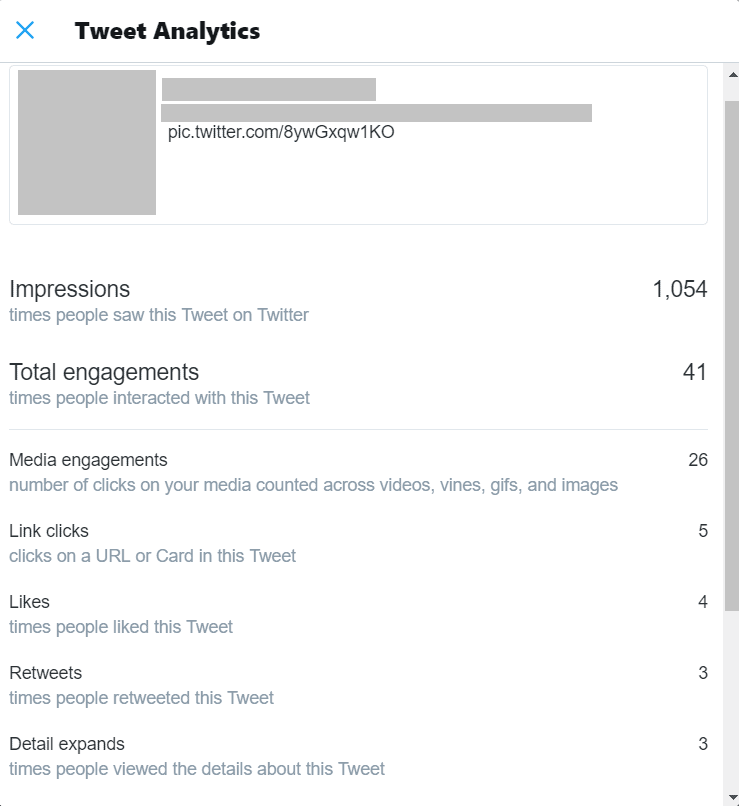
This is so because Twitter does not track reach.
You can see the impressions per tweet, or collective impressions for all your tweets in a given time frame, but you won’t be able to access reach – that is to say, unless you use a third-party analytics tool.
Related Topic: Top 25 social media analytics tools every marketer should use
If you do use a third-party app to gain access to detailed Twitter analytics reports, then reach will show you the size of the audience you have reached with your tweets – just like with other social media platforms.
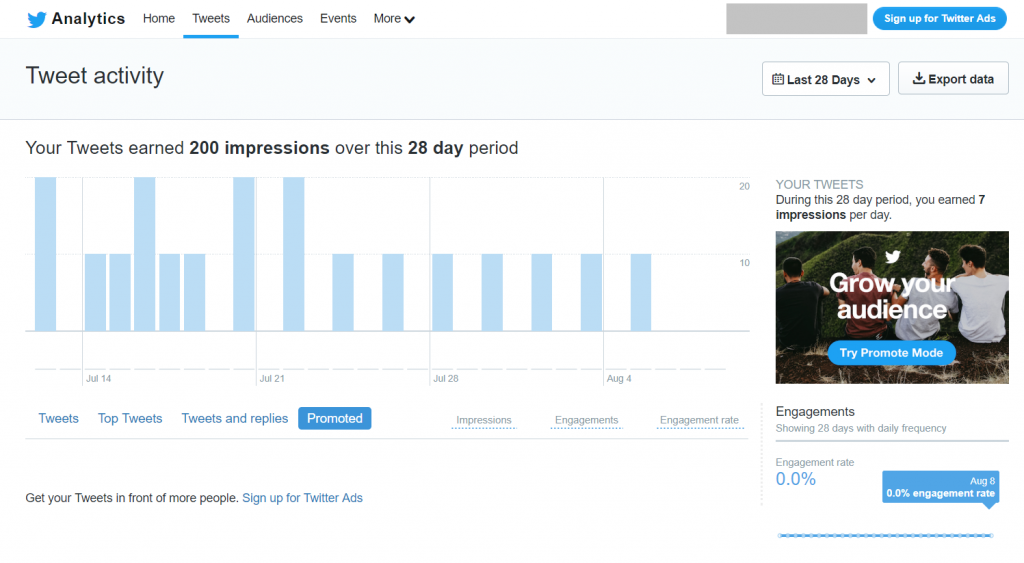
Twitter Impressions show the views of your tweets, or the number of times your Twitter content has shown up on someone’s feed, in search results, or to someone’s followers as a result of this someone interacting with your tweet.
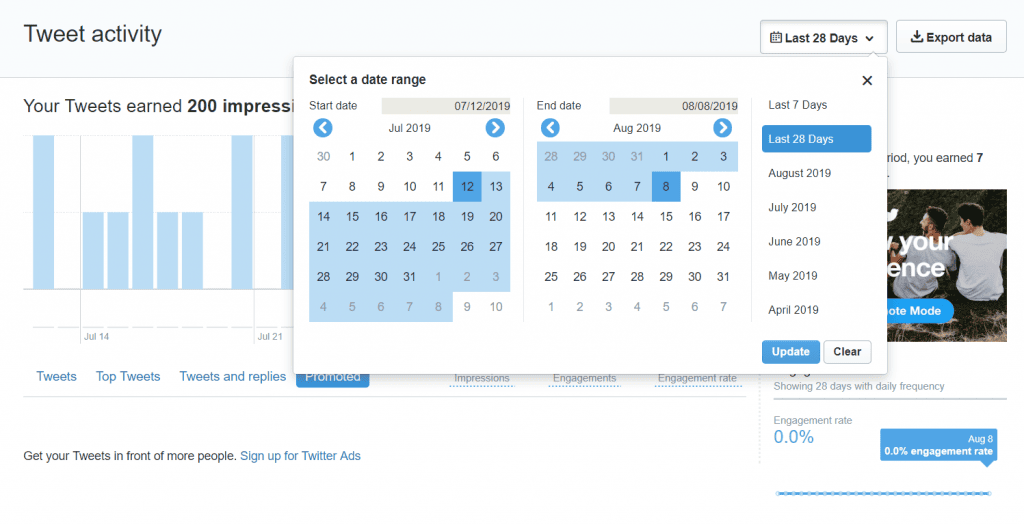
Impressions don’t show if your tweet has been seen via third-party platforms, via a text preview or as an embed on a website.
Tweet impressions show the strength of your brand presence. Most likely you will have to pair these insights with other metrics such as engagement to get an accurate idea of the relevance of your content.
Reach Vs. Impressions on Instagram
Just like Facebook, Instagram defines reach as the unique number of accounts that have seen your post or story, and impressions show the number of times a story or Instagram post has been displayed.
If you have Instagram creator account or business profile you can access these metrics by clicking ‘View Insights’ under an Instagram post, or swiping up the story you want to see the performance of.
Business profile doesn’t give in-depth insights on reach and impressions as creator profile but you sort of get the overall idea about reach and impressions.
As you can see in the image below, when you access the analytics of an Instagram post, you will not only be able to see the reach and impressions but also what percentage of users you reached that were not following you.
You can also see your impressions broken down by source: hashtags, home, profile, explore or other sources.

If you want to see a general performance of your posts, you can access your weekly reach and impressions in the Activity tab of Instagram Insights.
The reach and impressions numbers are displayed in the Discovery section, at the bottom of the Insights page.
Stories’ analytics does not break down the source of impressions or the percentage of people that were not following you but saw the story.
It will show how many of the people that saw the story navigated back, forward, to the next story, or completely exited Instagram stories after seeing your post.

The numbers in the navigation section should give you an idea of why the impressions are higher than your reach.
So, if a single user has gone back to see your story one more time or visited your profile multiple times, it will be counted as one reach and multiple impressions.
Reach vs. Impressions on other platforms
1. YouTube
YouTube analytics offers insight into four distinct reach metrics:
- Unique viewers is the same metric as ‘reach’ – it shows the number of people that watched your videos.
- Impressions show the number of times your video’s thumbnails were shown to viewers on YouTube.
- Traffic sources for impressions shows “where on YouTube your video thumbnails were shown to potential viewers.”
- Impressions click-through rate (CTR) shows conversions – how often users watched a video after being exposed to a thumbnail.
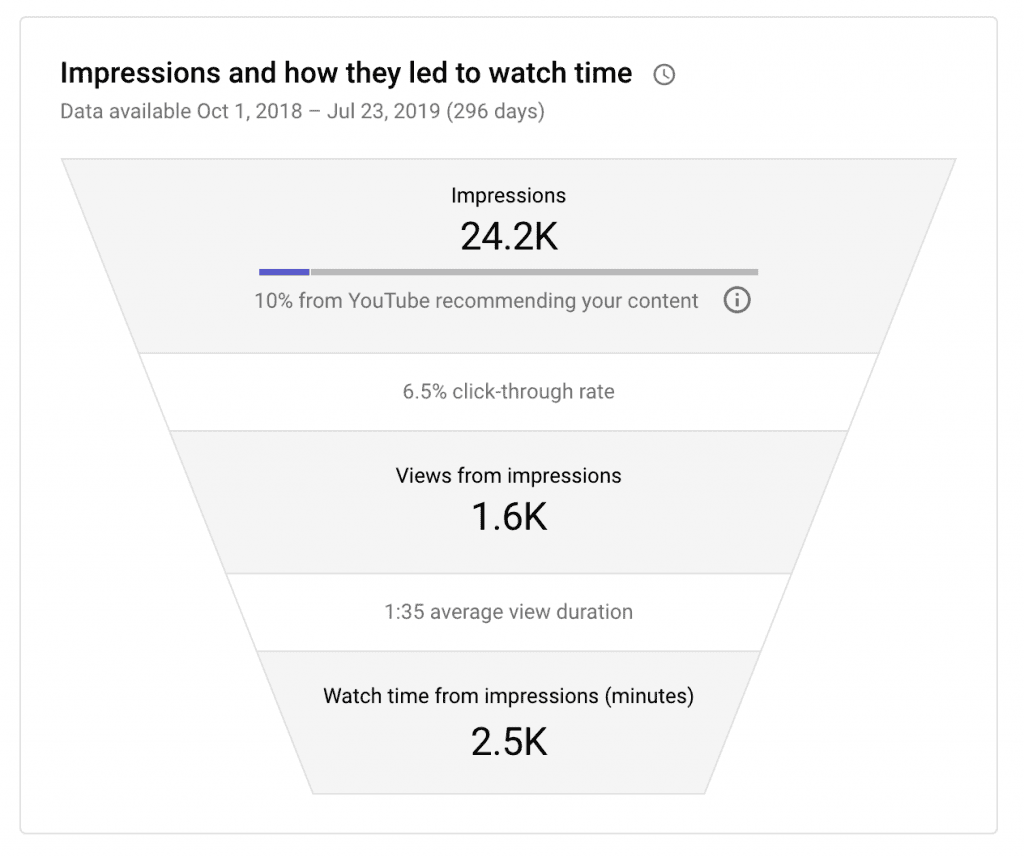
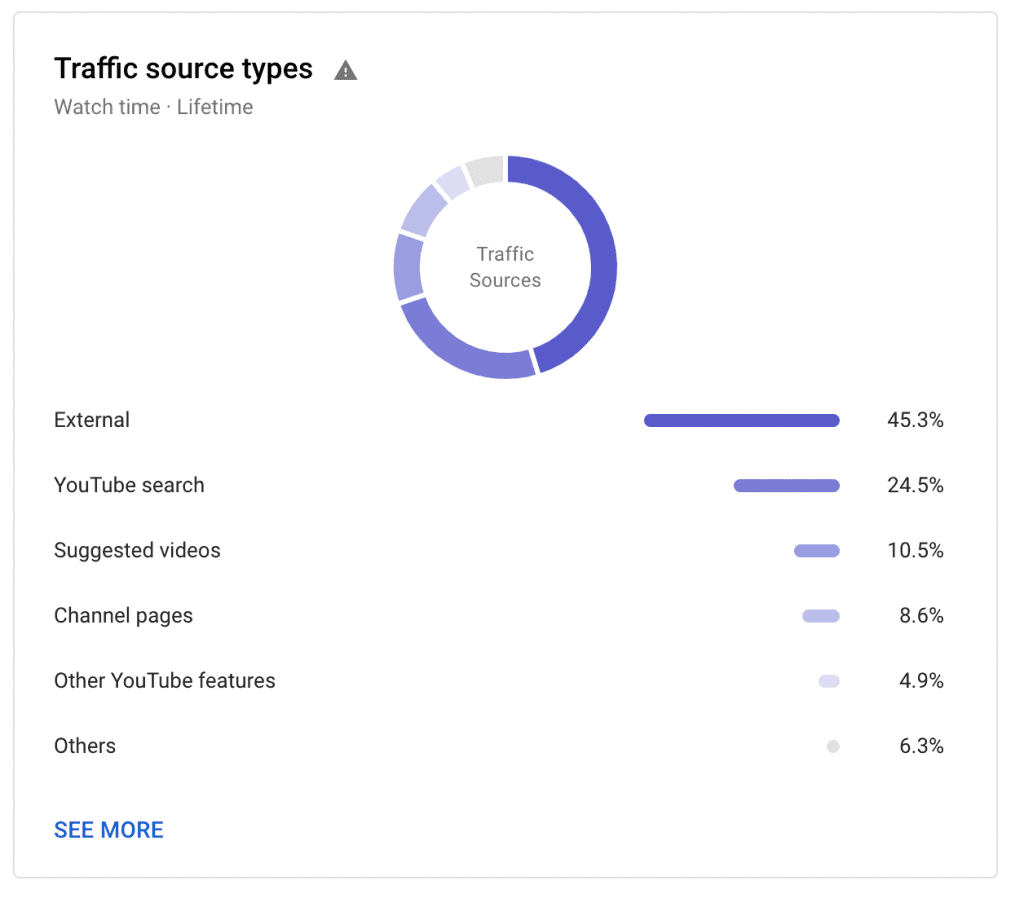
2. Snapchat

Snapchat has the same concept of reach and impressions, with the difference that it calls impressions story views.
3. Google Analytics
Google Analytics shows users and page views.
The metric ‘users’ is similar to reach – it shows the number of people that have visited your site at least once during a specific time window.
‘Page views’ shows the total number of page views coming from all your visitors. And now, with the rise of Google Analytics 4 (GA4), you can collect all the metrics in one place via integrations, like GA4 to BigQuery, to create developed live performance dashboards.
4. Google Ads
Google Ads differentiates between unique reach and cookie-based reach.
According to Google Ads Help, unique reach “measure the total number of people who were shown an ad… across different devices, formats, and networks.”
Unique reach includes two metrics: unique users, and average impression frequency per user.
Cookie-based reach are reach metrics based on cookies, which are calculated by counting the number of cookies that have been served an ad or recorded a click on an ad.
Since some people use more than one device or access pages via multiple browsers that have different cookies, cookie-based reach is an estimate and may include duplicate views.
Role of reach and impressions in your marketing strategy
Now you understand that although many people use the terms interchangeably, reach and impressions are two very different metrics.
But look.
We all know that theoretical knowledge has no purpose without the ability to act upon it.
So, how can you use what you just learned to boost your social media marketing strategy and drive results?
To answer this question, which is by no means simple, we first need to explain the impact each of these metrics could have on your marketing.
Let’s dig in.
Reach is the name of the game when…
Since reach is directly related to the number of unique users that are seeing your content, you can use reach to optimize your paid campaigns.
Namely, if your reach is high, your content is likely suitable for your target audience, which means that the chances of it being engaged with and/or shared are high.
However, if the reach is high, but the conversions don’t follow through and stay low, it’s safe to say that your funnel is not as effective as it should be and that you should revise and improve your ad.
Also, if you want to avoid showing your ads over and over again to the same people, focus on increasing your reach instead of impressions.
The road to success is paved with impressions when…
Impressions come in handy when you don’t want to wait too long to see whether an ad is effective. As impressions are a metric that changes moment-to-moment, track them to check how an ad performs immediately after it has been published.
If the ad gets no impressions, you might want to consider editing its content and republishing it to avoid losing time and amounting unnecessary costs.
When to focus on tracking both reach and impressions?
Just like with other social media metrics, more often than not, you will need to track both reach and impressions to figure out how effective your campaigns are and identify areas of improvement.
Tracking both metrics can mainly help you to:
1. Calculate your effective frequency
Impressions will always be higher than your reach – and that’s something that should be that way.
Why?
Many marketers agree that a user needs to see an ad several times before they show interest in a product and convert.
This is what’s known as effective frequency – the number of times people need to be exposed to a particular piece of content before they feel the urge to respond to it in some way.
What’s the best frequency?
Experts agree to disagree:
Some say 3 is a good number, while others swear by the lucky 7.
Your best bet is figuring out the effective frequency that works for you (of course, you can also try to figure out the effective frequency your competitors are aiming for as well).
To do this, find your most effective ads and posts (the content that converts) and divide each post’s total impressions with its overall reach.
2. Avoid ad fatigue
The effective frequency does not only tell you how many times a user needs to see a post because they respond to it…
… it also shows what your limits are before your target audience has had enough and you cross the thin line between being informative and consistently showing up on social media, and being annoying.
Just imagine how social media users feel when they’re bombarded by ads…
Doesn’t sound good, does it?
As you’d expect, just like with everything else on social media, there is no straightforward answer to how much is too much when it comes to frequency per user.
Again, it will all depend on your current campaign and goals.
If your campaign is time-sensitive, you will probably need to pour all your efforts into ensuring a higher frequency count.
If, however, you’re looking to steadily grow your audience and brand exposure and time is of no issue, take it easy and work on building reach through consistency.

You can tell a lot about the relevance of your message by tracking reach and impressions, but usually, that’s not enough.
Reach and impressions are just a starting point in figuring out the way to optimise your campaigns for the two metrics that have the most significant impact on your business: engagement and conversions.
Every social media campaign has the ultimate goal of raising awareness and starting conversations with the target audience by increased engagement.
If reach and impressions are high, but people don’t engage with the content be it in the form of likes, shares, or replies, it’s safe to assume that either something is wrong with the framing of the message or the targeting is off.
Furthermore, looking at reach and impressions in isolation can tell you nothing about your social media ROI.
To get a better feel for your advertising spend and return of investment, you need to juxtapose your reach with your conversions and revenue.
This way, you will be able to calculate the average revenue and conversions per user reached – which are much more concrete metrics that have a direct impact on your business success.
Last Notes
So, what’s the verdict?
Reach, or impressions? What’s more important to track?
It’s a simple question – with no simple answer.
In this article, we explained how both reach and impressions play an important part in your social media marketing strategy.
But, just like with other metrics, the one you decide to focus on will depend solely on your current marketing objectives.
Hopefully, after reading this article you are able to make a distinction.
Related Article:
5 Under-Analyzed Social Media Metrics that Matter [+ Free Tools to Measure Them!]
The Top 15 Instagram Analytics Tools [+ Metrics that Matter]
Frequently Asked Questions
Which is better reach or impressions?
Reach and impressions are used to measure engagement, but there is a key distinction between them: reach refers to the number of users who view your advertisements, whereas impressions refer to the number of times your ad is seen. You'll typically find that impressions are always higher than reach.
How are reach impressions calculated?
Reach is essentially calculated by dividing impressions by frequency (reach = impressions/frequency).
Why is my reach higher than impressions?
Reach and impressions differ in that they are time- and repetition-based. The number of total impressions of your content will exceed the reach as soon as the same user views it more than once or when they view a new piece of content linked to your business the following day.